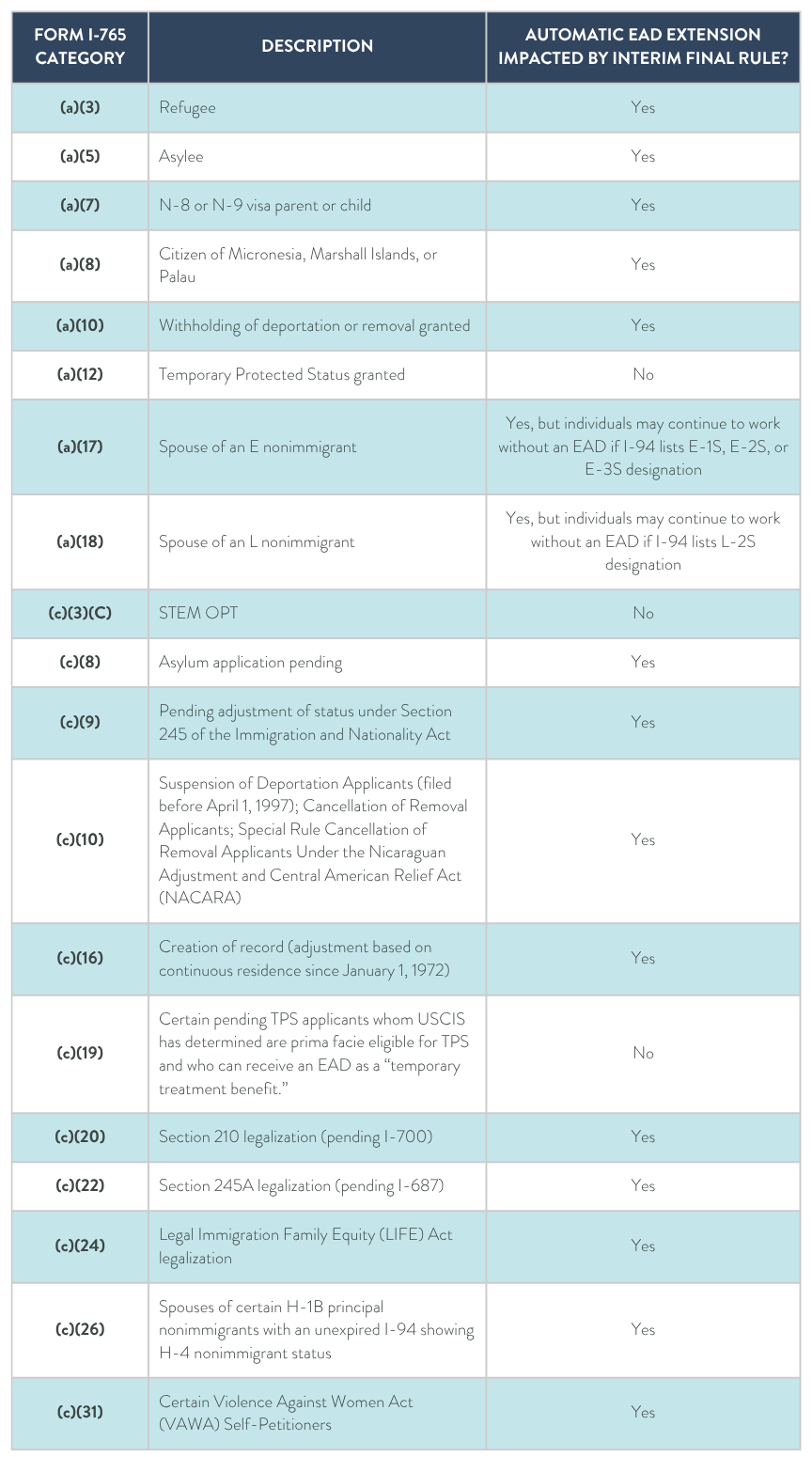U.S. Department of Homeland Security Ends Automatic EAD Extensions for Renewal Applicants
The Department of Homeland Security (DHS) published an interim final rule that eliminates the automatic extension of employment authorization documents (EADs) for most renewal applications filed on or after October 30, 2025. There is a 30-day comment period, but the rule is effective immediately, citing national security concerns.
The new rule states:
- Foreign nationals who file renewal of Form I-765, Application for Employment Authorization, on or after October 30, 2025, will not receive an automatic 540-day extension of their current EAD category simply by virtue of timely filing.
- There are limited exceptions, including extension provisions tied to TPS-based EADs (via Federal Register notices or statute).
- The change does not affect EADs that were automatically extended before October 30, 2025, under prior auto-extension rules.
- The rationale: DHS wishes to conduct more frequent screening and vetting of renewal applicants before granting extensions.
- U.S. Citizenship and Immigration Services (USCIS) is encouraging renewal filings to be submitted as early as possible and up to 180 days before expiration of the current EAD to reduce the risk of employment authorization lapses.
Key Implications and Next Steps for Employers and Employees Relying on EADs
Increased risk of employment authorization gaps
Without automatic extensions, foreign national employees who rely on EADs may face a gap between the expiration of their current EAD and a decision on the new application, during which they are not authorized to work. Employers must be vigilant in their Form I-9 compliance and the need for re-verification or updated documentation.
File early
Foreign national employees whose EADs expire soon should aim to file renewal applications as early as permitted (USCIS currently states up to 180 days before expiration) to mitigate the gap risk.
Review internal procedures and audit workforce
Employers should audit their workforce and identify employees with expiring EADs in the next 6 to 12 months. Employers should also update their HR and legal-immigration workflows to track upcoming EAD expirations, renewal filings, and monitor whether automatic extensions apply or have been eliminated for any given category. Organizations should ensure that Form I-9 re-verification (if applicable) is tracked and consider how the loss of automatic extensions affects Form I-9 re-verification timelines.
Categories likely impacted
While the rule text indicates "certain employment authorization categories," employers should assume broad applicability unless an employee’s eligibility category is explicitly exempt (for example, a TPS-based EAD that is subject to a separate extension notice). We recommend reviewing the affected employees’ eligibility category code and renewal status. Below is a list of EAD categories noting the category-specific impact of the new rule.

Examine eligibility category codes on EAD and I-797C receipt notice
Two particularly relevant codes that no longer qualify for automatic extension are:
- C09 — "Pending Adjustment of Status under Section 245 of the Act": This category applies to noncitizens who have filed for adjustment of status (via Form I-485) and have applied (or will apply) for an EAD based on that pending status.
- C26 — Spouses of certain H-1B principal nonimmigrants with H-4 non-immigrant status with an unexpired I-94 showing H-4 status: this category allows certain H-4 spouses to obtain EADs.
Update communications to foreign national employees
Employers may consider proactive outreach to their foreign national workers who presented EADs for completion of Form I-9. For example: advising them of the rule change, reminding them to closely monitor their EAD expiration date, filing renewals promptly, considering the possibility of work authorization interruption, and alerting HR if any issues arise.
Conclusion
This interim final rule from DHS significantly shifts the landscape for EAD renewals by ending automatic extensions for most renewal applications filed on or after October 30, 2025. Employers and employees who rely on EADs should act promptly to review, plan and file accordingly to avoid employment authorization gaps and compliance risks.
Should you have employees with EADs, we can assist in reviewing their eligibility categories, renewal timelines, different work authorization options, and internal HR procedures to safeguard continued work authorization.
We can support with developing contingency plans. In the event of a gap in authorization, consider how to manage payroll, benefits, assignments, and HR compliance; engage counsel if an employee’s work authorization lapses.
Stinson will continue to closely monitor developments and provide updates. For more information on how to audit your workforce, update your internal policies or prepare employee communications, please contact Renée Mueller Steinle, Olga Andreyeva, Elizabeth Chatham, Brad Sandler or the Stinson LLP contact with whom you regularly work.



